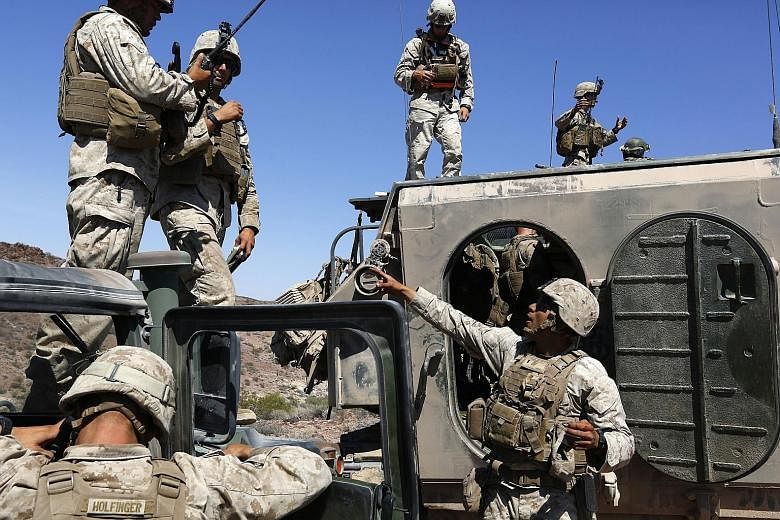TWENTYNINE PALMS (California) • Kilo Company of the 3rd Battalion, 2nd Marines was deep in a simulated firefight on a recent morning in the high California desert.
A group of Marines on the aptly named Machine Gun Hill unleashed live fire as another group of Marines tried to seize the surrounding valley from an imaginary enemy.
"They're dug in," shouted Chief Warrant Officer Brian Somers of Kilo Company, describing the "enemy" forces, supposedly supported by a real state with real resources and who were theoretically returning fire. "This is conventional warfare."
After 15 years of fighting terrorists, the US military is learning how to fight big armies again.
From the Middle East to South Asia to Africa, United States forces for the past decade and a half have fought counter-insurgency and counter-terrorist campaigns - essentially smaller-scale guerrilla warfare - rather than the large land wars of the past.
But Russia's invasion of Crimea, a surging China and an unpredictable North Korea have led US commanders to make sure soldiers, sailors, airmen and Marines are trained in conventional warfare.
It is part of learning how to fight what the Pentagon calls the hybrid wars of the future, envisioned as a mix of conventional battles, insurgencies and cyber-threats.
Army chief of staff Mark A. Milley said: "You're looking at a different level of capabilities when you're talking about a higher-end threat, and the US Army hasn't fought against that type of enemy in a long time."
Future wars, he said, "could have conventional forces, Special Forces, guerrillas, terrorists, criminals all mixed together in a highly complex environment, with potentially high densities of civilians."
In recent months, the Army has held training exercises with hundreds of troops, tanks, drones, missiles and armoured vehicles.
The exercises are far different from what the US faced in Afghanistan in 2001, when Al-Qaeda insurgents and Taleban fighters disappeared into the hills and mountains and pulled the US military into a counter-insurgency guerrilla campaign that is still ongoing.
Similar counter-insurgency campaigns were also fought by US forces against Iraq in 2003 and today against the Islamic State in Iraq and Syria (ISIS).
Marine Corps commandant Robert B. Neller said the next fight will be against "somebody who's got electronic warfare, armoured vehicles and the ability to manoeuvre".
On a recent morning at Twentynine Palms, Gen Neller was joined by Admiral John M. Richardson, chief of naval operations, to watch the training exercise - the first time a Navy chief had travelled to the Marine base to do so.
Defence officials say the changing nature of war calls for closer cooperation between the services. After the morning's live-fire mortar pounding from Machine Gun Hill, the two chiefs drove down the road to observe another exercise, the retaking of an occupied urban area.
The exercises showed that as US forces learn conventional warfare, they continue to train in counter-insurgency tactics to take on ISIS, Al-Qaeda, the Taleban - or some other group.
"We should not expect the Chinese and Russians to forgo counter-insurgency warfare," said Dr Kathleen H. Hicks, director of the international security programme at the Centre for Strategic and International Studies. Or, she said, "they may mass and stand and fight".
NEW YORK TIMES

